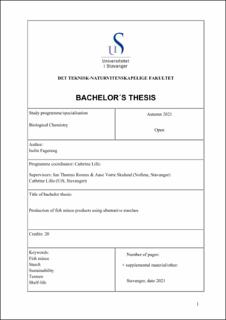| dc.description.abstract | Starch is one of the major ingredients that is incorporated into minced fish products due to its ability to modify the texture and improve the stability during refrigerated storage. Fish mince products were developed that contained different starches. Potato starch is a commonly used starch ingredient in fish mince products. The aim of this thesis was to produce fish mince products with specific textural and structural attributes and with a long shelf-life (up to 30 days), using an alternative and sustainable starch ingredient. It was also analysed what effect two different packaging methods (casings and modified atmosphere packaging (MAP)) had on the properties and on the shelf-life of the products.
Preliminary analyses of fish mince with different starches were performed to find suitable starches to use further in the pilot production being the shelf-life study. Based on the results found from the preliminary productions, two variants of fish mince were further analysed in the shelf-life study: one containing potato starch (“Potetmel”, Hoff, Norway) and one containing native pea starch (AMN Pea Flour Concentrate Ground Pellet, Food Grade, Norway). Texture analyses of the potato starch variant (MAP), the potato starch variant (stored in casings) and the native pea starch variant showed that some of the samples from the pea starch variant showed lower measurements in hardness (p < 0.001), chewiness (p= 0.001), gumminess (p < 0.001), springiness (p= 0.324), cohesiveness (p= 0.043), and resilience (p= 0.027) than some samples from the other variants. The resulting parameters obtained from the texture profile analyses (TPA) suggest that the storage time and packaging have little impact on the texture of the products. All three variants had had a significant (p < 0.001) decrease in the water holding capacity (WHC) from day 17 to 28. The results from the colour measurements in the colour coordinate b* in the shelf-life study showed that the native pea starch variant had a more yellow colour than the potato starch variant. From the sensory evaluation a trend was observed within the taste of the samples correlating with the storage time, where the fish taste became more indistinct and less fresh/pure. The results from the microbiological analyses of the fish mince products correlated with the sensory evaluation of the samples on the last day of analyses (day 29), where there was an increase in the bacterial count of spoilage organisms found on the samples. Based on the microbiological analyses and the sensory evaluation of the variants the products were thought to have a shelf-life of at least 28 days. The textural and sensory properties of the fish mince variants suggests that native pea starch could be a good and sustainable alternative starch ingredient in fish mince products. | |
